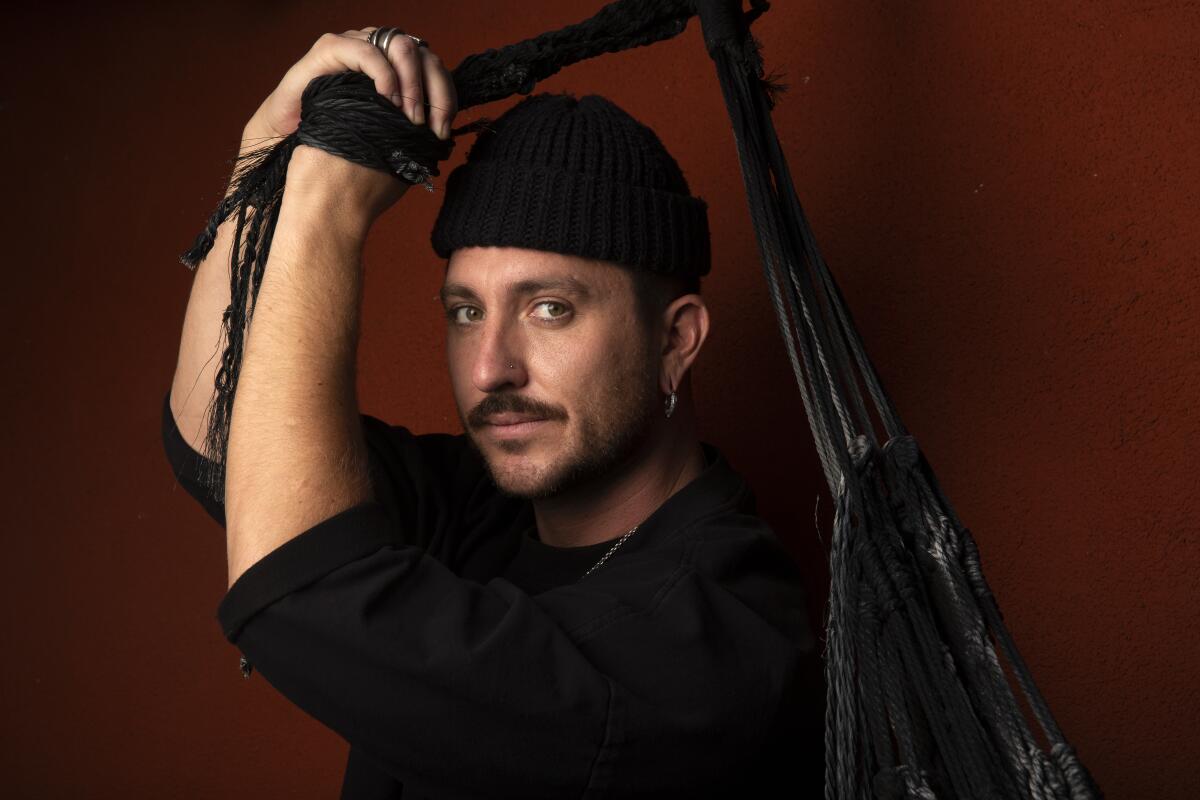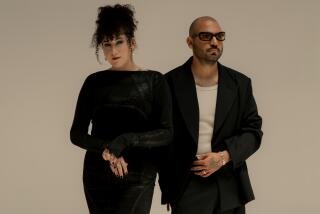‘Our sales jumped 500%’: Meet the L.A.-based designer who won an Amazon reality show

Even if it hadn’t debuted just as the global coronavirus pandemic was profoundly reshaping the worlds of entertainment, fashion and retail, Amazon’s foray into reality television — the 10-episode “Making the Cut,” which concluded its first season Friday — was destined to be a game-changer. Not just because it reunited “Project Runway” dynamic duo Heidi Klum and Tim Gunn but also because each episode would see at least one garment go straight from the runway to retail in Amazon Fashion’s online store, making “shop-the-screen” entertainment as easy as a couple of mouse clicks.
It also turned out to be a game-changer — not to mention career accelerator — for freshly minted winner Jonny Cota, founder and creative director of 14-year-old, DTLA-based fashion brand Skingraft, who bested 11 other designers from around the world to win $1 million in prize money, a yearlong mentorship with Amazon Fashion and an online Amazon store showcasing his 20-piece finale collection.
In advance of Friday’s finale, we caught up with Cota, whose work has been on our radar for the better part of two decades, to talk about his “Making the Cut” experience, including where that prize money went, what surprised him most about the show and whether judge Naomi Campbell was as scary in person as she was from the safety of our couches. (She was, he says, and then some.)
Below are excerpts from that conversation, edited for clarity and condensed.
Times fashion critic Adam Tschorn offers his thoughts on Episodes 9 and 10 of Amazon’s fashion competition “Making the Cut.”
Let’s start with the most obvious question: What did you do with the $1 million prize money?
All of 2020 is being funded by the $1 million prize I won on “Making the Cut” ... launching the [new] brand [Jonny Cota], continuing with Skingraft, the mentorship with Amazon. ... This year is fully funded and we are full steam ahead.
What is the single most important thing that you hope to gain from the mentorship part of the prize?
What I’ve experienced so far — and what I hope to continue to gain from the Amazon Fashion mentorship — is how to speak directly to my customers, how to bring my niche brand, my niche aesthetic, into a global market. [We’re using] clear imagery, concise descriptions about the fit, [and we’ve] fully updated size charts. These are all things I have not done a great job [with] over the last 10 years and they are really just mentoring me to make a much more accessible, much more optimistic version of my brand.
Each of the episodes focused on a different aspect of growing a label — things like collaborating, evolving, creating a business plan. Was there one of these that you felt was most beneficial in charting your own path forward?
The digital campaign episode. I was waiting for something like that all season. I was like, “I thought we weren’t really sewing on this show” and every episode we would sew. So when we finally got the opportunity to show a different skill set that a creative director would have to have — how to conceive of, direct and style a strong campaign — I knew as soon as they announced that assignment [that] I would excel. And I did. [But] then, after celebrating my campaign, [the judges] spent a few minutes talking about how much they hated the name Skingraft.
Where did the name Skingraft come from in the first place?
When we first started, I had zero budget and my first collection of leather jackets was made out of leather scraps that came from secondhand pieces from Goodwill. Every little piece was no bigger than a few inches and it was all terribly sewn together. A friend pointed out that it looked like skin grafts and I was like: “That’s exactly what the brand is going to be called!”
What’s the current status of that label?
I’m launching my exclusive collection with Amazon [Fashion] called Jonny Cota Studio and I will continue to put the majority of my energy into everything Jonny Cota. Skingraft will remain and it will continue to be its goth-y little self, but I’ve been waiting for years to go by my [name] and come out from behind the curtain and step into my own in the spotlight. So 2020 — and the future — is all about [the] Jonny Cota [label].
For people who might not have seen the show — or realize that it included the birth of a new namesake label — how would you describe the difference between Skingraft and the new Jonny Cota brand?
Skingraft is very niche, it’s hard, it’s fierce, it’s dark, it’s downtown L.A. — it’s all the things I love. And that’s still me. But through my journey on the show I started peeling back some of the hardness and it revealed a softer, more feminine side. I played with prints, I played with silks, I played with just kind of letting it go and see what comes. [The new line] is still from the same mind and the same world — it’s not drastically different — I just think that Jonny Cota is designed for a wider audience. For the first time in my life, I couldn’t be more excited about being accessible to the world rather than just being a downtown niche [brand].
Did you notice any kind of halo effect on your existing business once episodes started streaming?
During the show, our sales jumped about 500%. It’s been a super-exciting month for us. We [had been] playing with the idea of actually wrapping up Skingraft at the end of the show, but now it has this new momentum, new clientele, new energy and new excitement, so I think that both brands will continue to run.
If and when there’s another season of “Making the Cut,” what advice would you give to prospective contestants?
Meditate on who you are as a designer and who you want to be. I arrived on this competition thinking I was just going to make pretty looks and send them down the runway — you’re in, you’re out, whatever. I didn’t realize we would be so challenged to constantly defend ourselves, to clearly explain our inspiration, to excite the judges and the people around us with what we [were] saying. I wasn’t prepared for that [and] in the first few episodes I kind of struggled. [Eventually] I understood that the show was mirroring the real world and [that] being well-spoken is one of the greatest strengths you can have as a designer. Designers should focus on their voice. Who are you? What is your aesthetic?
L.A. Times TV editor Matt Brennan interviews ‘Making the Cut’ and ‘Project Runway’ star Tim Gunn about his mentorship style.
How has appearing on “Making the Cut” affected the trajectory of your career?
You’ve been with me from the beginning — you were one of my very first reviews — so you’ve seen how I’ve been hustling in L.A. for 10 years. And I’ve gotten a lot of traction that I’m grateful for. But it’s really hard to break through that glass ceiling of L.A. fashion. So I think that “Making the Cut” has just cut about 10 years out of my career path and it’s given me this major boost that I couldn’t have gotten if I’d just continued on the same path.
Speaking of L.A., do you feel that being based here gave you any kind of advantage in navigating the entertainment world?
Being from L.A. — or from New York or from any major city that has an entertainment industry — gives you an understanding that everything matters. I know [the show] is about celebrating our designs and judging our strengths as designers but I watch TV, I live in L.A., I get it. How you come off, how you interview, how you speak about your inspiration — it all matters.
Was there anything about how the show came together that surprised you?
I was shocked how little the “Making the Cut” production [team] encouraged specific interactions. The show never set up any fake scenes. They’d say something like: “Hey, you’re going to have lunch together,” and we’d all be like: “Should we be fighting? Should there be more drama?” I grew up on reality TV, so [I was thinking], “Shouldn’t they set up some sort of [confrontation]?” We kept waiting and wondering when the drama was going to happen. But they just captured everything that happened; they never set up a situation.
Since the coronavirus pandemic began, a lot of fashion brands and designers have pivoted to making masks and other personal protective equipment. How have you been involved?
Skingraft did a really cool promotion last week. We teamed up with the Tom of Finland store and offered a one-for-one deal where they sold our famous Skingraft fabric masks and for every mask purchased we donated one to the Los Angeles LGBT Center for their workers. We just sent off our first shipment to the LGBT Center the other day and another one is leaving at the end of the week and that’s over 200 masks going to them.
Is Naomi Campbell as terrifying when you’re standing there being judged by her as she is when we’re watching from home?
She’s 10 times scarier in real life — and 10 times more beautiful. She’s been stunning on magazine covers her whole life and then when you see her in person you think: “You are not from this planet. You are the most beautiful alien I have ever seen.”
Before the coronavirus pandemic changed the world so dramatically, how were you planning to mark the airing of the finale and celebrate your big win?
I thought I would be out celebrating with all my friends and having the biggest watch party of my life — the Super Bowl of Jonny Cota — but instead I’m organizing a big Zoom party with my friends, my family and my husband, who is making a big fancy cocktail. We’re just going to make the best of it.
Is the cocktail going to be called the Jonny Cota?
Of course it’s called the Jonny Cota — and it’s served up!
Last question: What was the last thing you ordered on Amazon?
My ring light for all my Zoom parties.
More to Read
The complete guide to home viewing
Get Screen Gab for everything about the TV shows and streaming movies everyone’s talking about.
You may occasionally receive promotional content from the Los Angeles Times.







